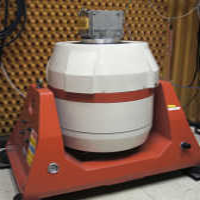Variable Frequency Vibration Testing
Variable frequency vibration is the normal test specified for electronic components and assemblies. Typically the test consists of a platform driven by a simple harmonic motion from a minimum frequency to an upper frequency and a return back to the minimum in an approximate logarithmic rate. The motion is usually limited to a peak amplitude at low frequencies and a maximum G level above a corner frequency.
This corner frequency may be calculated from:
f=(a/0.0512d) ½
Where a is gravitational units (g), d is displacement of a p-p cycle (Inches) and f is frequency (Hz).
This cycle is typically repeated four times in each of three axes.
Variable Frequency Vibration testing is performed to evaluate the ability of parts to withstand vibration of varying frequency within a specified frequency range. The variable frequency vibration test simulates moderate to severe vibration as a result of motion produced by transportation or field operation. Vibration of this type may disturb operating characteristics, particularly if the repetitive stress causes fatigue. Most vibrations encountered in field service and/or transportation is not of a simple harmonic nature, but tests based on vibrations prove satisfactory for determining critical frequencies, modes of vibration and other data necessary for planning protective steps against the effects of undue vibration.
For design purposes, a swept frequency sinusoidal test may yield more pertinent information (such as resonant frequencies and modes) than a random vibration test. Vibration testing is considered to be destructive.
- Test Specifications / Standards
- MIL-STD-202 Method 201
- MIL-STD-750 Method 2056
- MIL-STD-883 Method 2007
- AEC-Q100
- AEC-Q101
- JESD22-B103
Suitability and Accreditation
ORS is certified for component vibration testing under MIL-STD 202 method 201, MIL-STD 750 method 2056, and MIL-STD 883 method 2007. ORS is also certified for Vibration Fatigue testing under MIL-STD 750 method 2046.




